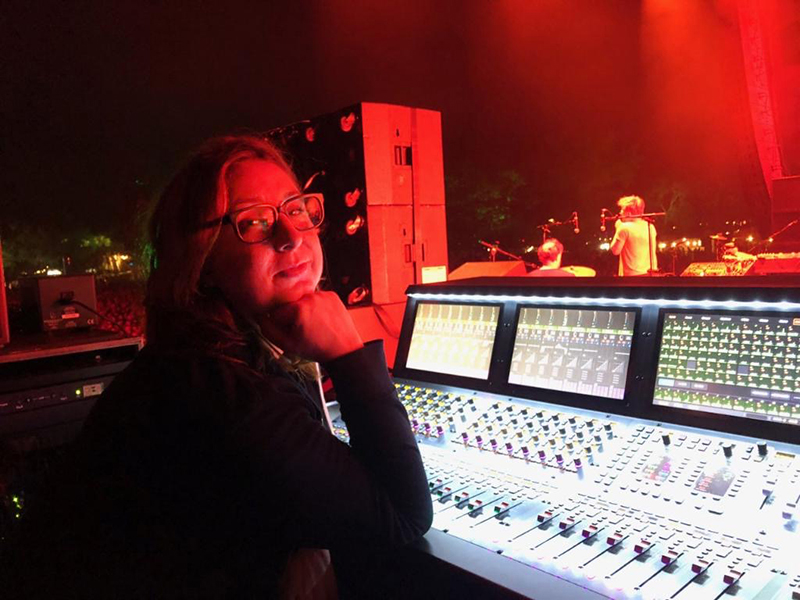
Asking The Right Question
The direction Moon was to take professionally was determined in 1998 when she approached Mudhoney’s sound engineer at a show at Seattle’s Summer Nights at the Pier and asked: “What do I have to do to be you?”
She explains, “It was an out-of-the-blue moment. I was about 24. I’d been studying environmental science at a college in Olympia, but felt it was time to decide what I really wanted to do and go for whatever that was. Watching Mudhoney’s engineer I was thinking, maybe that’s what I should do.”
Taking his subsequent advice to heart, Moon began studying music technology at Shoreline Community College, which boosted her confidence and allowed her to study piano, music theory, and all aspects of music production while interning at local studios and clubs like the Central Saloon. When that venue’s regular house engineer was let go (allegedly for making a musician cry) the booking agent offered her the gig. For roughly five years, she served as Central’s head engineer, while doing regional tours with various bands and working at local production company Carlson Audio, expanding her skills as a technician and mixing corporate events and casino shows.
As prepared as she was, there were sometimes unpleasant surprises on early tours. As an example, she cites one club on a European tour with the Yeah Yeah Yeahs. “I was ringing out the side fills and there’s this scratching, electronic sound and I’m like, ‘What is that?’ And they said: ‘Rats.’ They actually had rats living in the speakers. That’s one of my favorites, but I’m really thankful for those experiences.”
The social side of mixing the stage is a huge part of the job, Moon explains, adding that it’s hard not to take it personally when an artist is upset with their sound on stage, so a thick skin and excellent lines of communications, such as Moon has developed with artists she’s worked with regularly, are key. “I’m the closest person to them in their most vulnerable state. It’s a different kind of relationship than parachuting into a gig. It’s almost like you become a part of the band.”
Death Cab for Cutie actually considered cancelling tour dates when Moon came down with Chickenpox during a run through Asia. “They didn’t want the shows to be uncomfortable. Obviously, that’s something built over many tour cycles. I sometimes know what they want before they do. I can see the look on their faces and realize something is needed, so they definitely feel safer.”
Plying The Craft
Moon’s reputation for composure in challenging situations ultimately helped grow her roster of touring artists who, in turn, have become family, such as LCD Soundsystem, who she’s been working with since 2010 and who have a unique approach to collaboration on and off stage. It’s a collaboration that begins in the studio, even before their records are finished, with listening and consulting on the live approach with singer James Murphy – an engineer and DJ in his own right.

Prior to the band’s 2018 tour they rehearsed with Moon for three months to determine how best to translate the record to live performance. “Everything’s played live and there’s a ton of modular synths and moody equipment, so it can be an explosive stage,” she says. “Consistency is everything. That’s what the artist wants, but sometimes the gear can be a part of why it’s not consistent, so working with backline techs, making sure that we’re getting the same sounds and levels every day, is a huge part of it.”
With LCD Soundsystem, monitor world is literally part of the show: “They roll my whole riser – with all my amps and console – out on stage. That’s a switch from situations where you’re trying to hide, or worse, where you have to fight for a place where you can see the band and they see you. To work for someone who treats you like part of the band is great, and the energy that goes along with it is amazing, but (being on stage) is strange.”
A longtime Avid user, Moon’s current go-to console is an S6L. “It sounds amazing, but I feel that with good musicians, microphones that are right for the job, and a nice sounding preamp you really can’t go wrong.”
For in-ear monitors, Ultimate Ears are the choice, and with bands that prefer wedges, d&b audiotechnik M2s or, as is the case of Murphy, a mix of M2s and M4s. Roughly half the artists Moon works with use wedges rather than IEMs. “And if they’re happy there’s no reason to move to in ears, but there is a huge push to do so; from other artists, from engineers or managers – they really want everyone on IEMs.”
Although the main selling point for IEMs is consistency, Moon cautions: “There’s still a room involved. When I switched from wedges to mixing in ears, it was a big adjustment because there’s no hiding what’s being played – or my mistakes for that matter. But I don’t have a preference. Whatever keeps the artist happy is what I prefer.”
